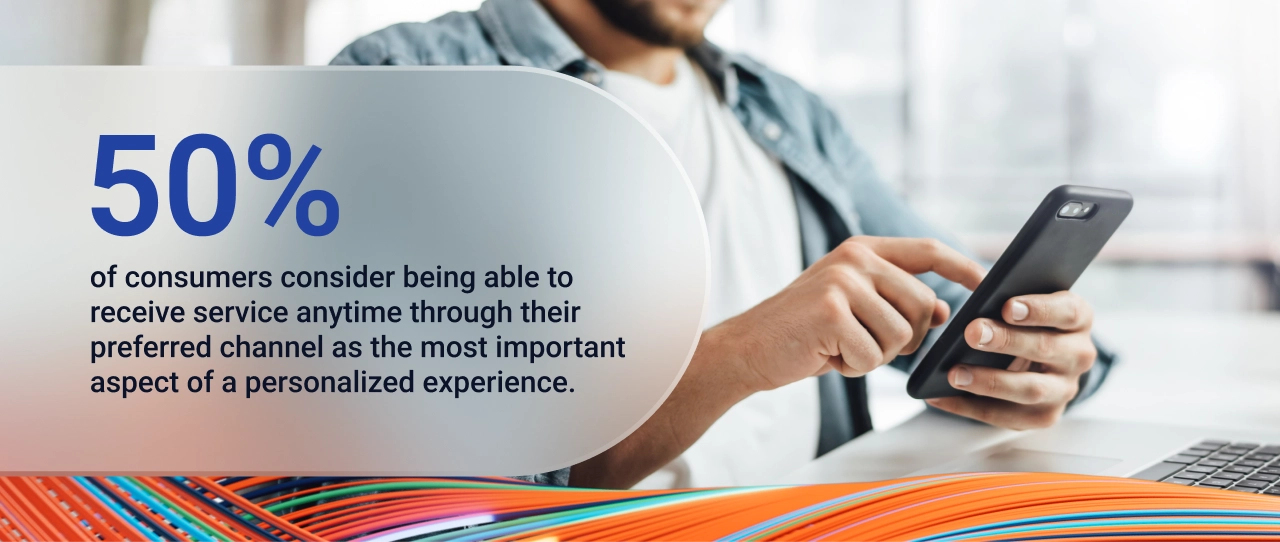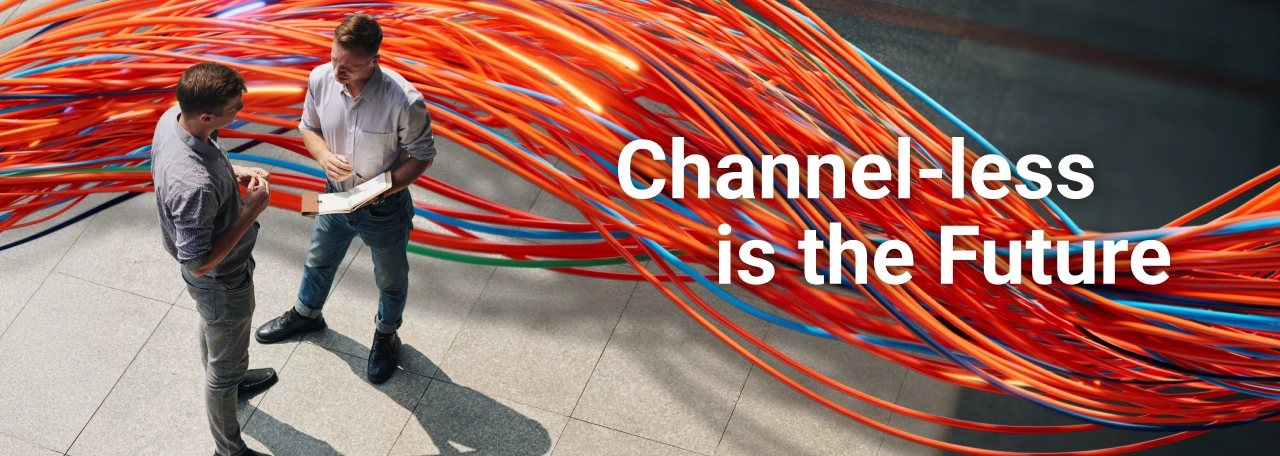Your Genesys Blog Subscription has been confirmed!
Please add genesys@email.genesys.com to your safe sender list to ensure you receive the weekly blog notifications.
Subscribe to our free newsletter and get blog updates in your inbox
Don't Show This Again.

In today’s digital-first world, customers don’t think in terms of “channels.” They think more in terms of experiences. Whether they start a conversation on Facebook, escalate it via WhatsApp or finish it on a phone call, they expect consistency, speed and personalization.
For businesses, this means the old way of managing customer engagement using siloed, channel-specific strategies is no longer enough. Enter the channel-less approach: a model where customer experiences can flow effortlessly across platforms and touchpoints. It’s a model that’s guided by unified data and intelligent automation that’s intended to drive personalization at scale.
In this article, we’ll dive into the evolution from omnichannel CX, what channel-less means, why it matters and how businesses can successfully adopt it to elevate their customer experience.
There’s a lot of potential value in adding additional channels as part of your CX strategy. In fact, a survey of over 5,000 consumers revealed that 50% consider being able to receive service anytime through their preferred channel as the most important aspect of a personalized experience.

While it’s important for businesses to offer more digital options, it’s equally important to recognize that customers don’t view their experiences through a channel-specific lens. For example, if someone has a poor interaction on WhatsApp, they’re unlikely to say, “This brand struggles on WhatsApp.” Instead, they’ll likely say the brand offers poor support overall, and that sentiment will likely show up in feedback or surveys.
They see one brand, one journey.
A channel-less strategy prioritizes seamless transitions, not channel management. It helps ensure that no matter how a customer chooses to engage the context, personalization and continuity are preserved.
This model enables businesses to:
Adopting a channel-less model isn’t just a technology shift but rather it’s a mindset and operational shift. Here are key best practices to guide your journey:
A true channel-less experience starts with a unified workspace. Give your agents a single interface where they can manage all conversations across channels. This reduces complexity, minimizes toggling between tools, and enables agents to deliver faster, more informed service.
Customers expect the same level of responsiveness regardless of how they reach out. By applying uniform routing and queuing rules across channels, you enable reliable support and reduce inconsistencies in wait times, improving overall satisfaction.
One of the biggest frustrations for customers is having to repeat themselves. In fact, in “The State of Customer Experience” report, 36% of consumers surveyed globally say repeating themselves is highly frustrating, 22% say it upsets them so much that they either want to cry, scream or stop doing business with the offending organization.
A channel-less approach keeps interactions threaded and contextual, even as they move between platforms. If a customer starts on Instagram and shifts to email, the agent should see the full journey and respond without missing a beat.
AI is a key enabler of channel-less CX. From recognizing customer intent to automating routine tasks and intelligently escalating complex issues, AI helps personalize experiences while reducing the workload on agents. The result: faster resolutions, smarter interactions and more meaningful outcomes at scale.
A channel-less strategy is a transformational approach to CX. Here are a few real-world use cases that benefit most from this approach:
Retail and eCommerce
Shoppers might discover a product on Instagram, message the brand with a question and later follow up via web chat or WhatsApp to finalize their order. A channel-less strategy helps agents see the entire journey, providing faster, more personalized responses without customers needing to repeat themselves.
This can drive not just satisfaction, but ideally conversions as customers more through the process faster without reason to second guess or delay doing business with your brand.
Travel and Hospitality
In high-pressure scenarios like flight changes or last-minute bookings, travelers expect fast support. With channel-less CX, airlines and hotels can link messaging, voice and email touchpoints, preserving context across every interaction. Customers can switch from chat to voice without disruption, while agents stay fully informed.

Financial Services
Whether it’s applying for a loan, checking account details or getting support on a transaction, financial customers often shift between web, mobile and messaging channels. A channel-less approach enables secure, real-time service with consistent information and smooth transitions — improving both satisfaction and trust.
Public Sector and Utilities
Citizens may start with a question on social media, continue it over email and complete it via a call. A unified, channel-less model helps public-facing organizations deliver accessible, efficient support while maintaining full context throughout the journey.
In CX, social listening is no longer just a marketing tool. It’s a critical component of delivering timely, proactive and personalized service.
As more customer conversations happen publicly on social media platforms like Facebook, Instagram and X (formerly Twitter), brands must be equipped to monitor, interpret and respond to those signals as part of their overall customer engagement strategy.
A channel-less approach connects social listening with other digital and voice channels to help ensure that no interaction — whether it’s public or private — is left out of the customer journey.
Here’s how social listening supports and strengthens a channel-less strategy:
When combined with other digital touchpoints, social listening completes the picture as part of a holistic approach to a channel-less strategy.
At Genesys, we’re committed to helping organizations move beyond siloed interactions and embrace a channel-less approach to customer experience. We continue to invest in innovative tools that make it easier to deliver seamless, connected journeys across every touchpoint, regardless of where the conversation begins or ends.
The Genesys Cloud™ platform provides a unified agent desktop where interactions from SMS texts, messaging apps like WhatsApp, Facebook (both public posts and Messenger DMs), and more can be managed alongside traditional channels like voice and email. This centralization gives agents greater visibility and allows them to work more efficiently without switching between tools or losing context.
Genesys Cloud also helps to ensure that conversations are persistent and single-threaded, meaning agents and customers can pick up exactly where they left off even across devices or sessions. By maintaining a unified customer profile, interactions are informed by past behaviors and preferences, allowing for smarter, more personalized service.
Beyond messaging, Genesys Cloud empowers teams to engage with public conversations on platforms like Facebook, Instagram and X/Twitter. Through social listening and AI-powered sentiment analysis, businesses can detect high-priority posts and apply custom escalation rules to route them to the right agent before issues escalate publicly.
In addition, embedded AI capabilities power features like proactive outreach, predictive routing and AI-led self-service across these channels to create that fluid experience at the heart of channel-less. These tools not only lighten the load on human agents but also help ensure that customers get fast, relevant responses at every stage of their journey.
Together, these capabilities form the foundation of a scalable, channel-less experience that allows businesses to transform how they engage with customers.

The future of CX isn’t rooted in simply adding more channels; it moves beyond omnichannel customer experience. It’s about creating more connected, effortless experiences.
Genesys Cloud enables businesses to move beyond channel management and focus on journey orchestration, proactive service and data-driven personalization. With AI, automation and native support for critical digital channels, Genesys makes channel-less CX not only possible — it also makes it powerful.
If you’re ready to rethink your customer experience strategy, now is the time to go channel-less. Let’s keep the conversation going. Get a demo today to learn how you can elevate your digital strategy with Genesys Cloud. And then read this guide to learn how to build out your digital strategy to give customers a seamless, personalized and channel-less experience.
Subscribe to our free newsletter and get blog updates in your inbox.